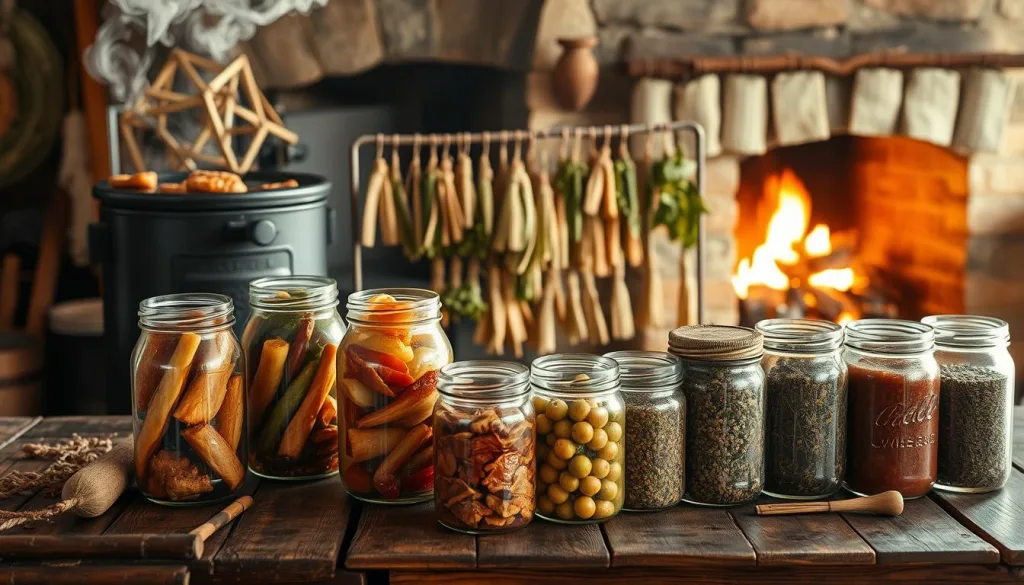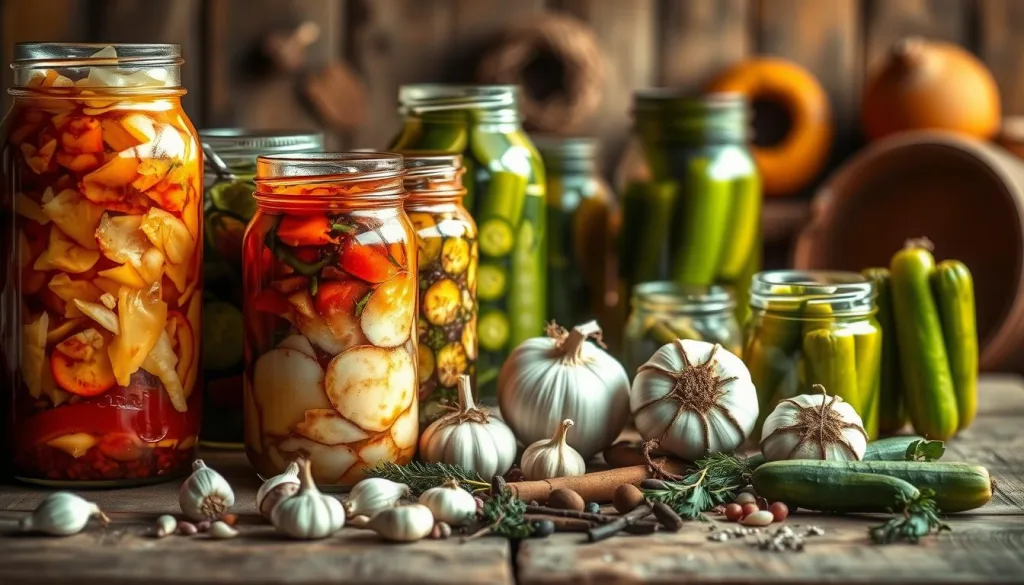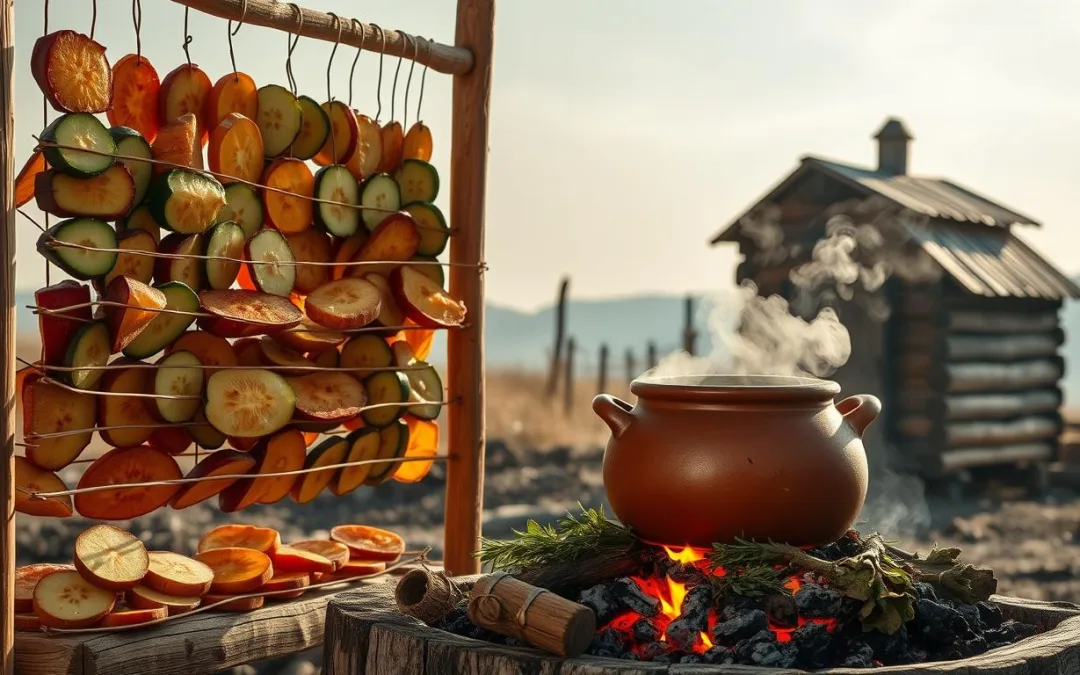For centuries, people have found clever ways to keep food fresh without refrigerators. These methods were key to survival, helping communities keep vital nutrients when times were tough. As someone who’s studied non-refrigerated food storage, I’ve learned many techniques to safely keep food fresh longer.
Preserving food without refrigeration is more than just a survival trick—it’s a skill passed down through ages. From ancient times to today’s off-grid folks, these methods keep food good and nutritious without needing electricity. Whether you’re getting ready for emergencies, living far from cities, or just want to use less modern tech, knowing these methods is very empowering.
Key Takeaways
- Food preservation techniques can extend food shelf life significantly
- Multiple traditional methods exist for storing food without refrigeration
- Proper techniques maintain food’s nutritional value and taste
- Non-refrigerated food storage skills are valuable for emergencies
- Understanding preservation methods can save money and reduce waste
Understanding Traditional Food Preservation Methods
Food preservation is a key skill that has helped humans for thousands of years. Traditional food preservation techniques kept communities fed during tough times before refrigerators were invented.
Our ancestors came up with smart ways to keep food fresh for a long time. They used these methods to survive the winter when fresh food was hard to find.
Historical Background of Food Preservation
Food preservation has a long history, dating back to ancient times. People found many ways to make food last longer:
- Salt curing for meat conservation
- Sun drying for fruits and vegetables
- Fermentation of dairy and vegetables
- Smoking meats to prevent bacterial growth
Benefits of Non-Electric Food Storage
Non-electric food preservation has big benefits today. These methods help us not rely so much on electricity and offer green ways to store food.
| Preservation Method | Key Benefits | Typical Foods Preserved |
|---|---|---|
| Drying | Lightweight, Long-lasting | Fruits, Herbs, Meats |
| Fermentation | Enhances Nutrition | Vegetables, Dairy Products |
| Canning | Extended Shelf Life | Fruits, Vegetables, Sauces |
Key Principles of Food Preservation
Good food preservation means controlling things that help bacteria grow. The main ideas are to reduce moisture, manage temperature, and make it hard for microbes to live.
“Preservation is not just about extending food’s life, but maintaining its nutritional integrity and flavor.” – Culinary Preservation Expert
Essential Equipment and Materials for Food Preservation
Learning how to preserve food without refrigeration is key. It’s useful for emergencies or for those who want to store food sustainably. Having the right tools is essential for your journey in food preservation.
Your toolkit should have important items for food conservation:
- Airtight storage containers
- Drying racks
- Salt and sugar for curing
- Vinegar for pickling
- Terracotta pots for zeer pot cooling
- Mason jars for canning
Preservation techniques need specific tools to keep food fresh longer. Airtight containers can make food last up to 50% longer. They are a must-have for serious food preservation.
Here are more essential materials for preservation:
- Dehydration screens
- Smoking racks
- Root cellar shelving
- Fermenting crocks
- Canning pressure cookers
Choose equipment that’s durable and of high quality. Stainless steel, glass, and ceramics are best for long-term food storage. Good tools ensure your food stays safe and fresh.
The right equipment transforms food preservation from a challenge to an art form.
Drying and Dehydration Techniques
For centuries, drying food has been key to survival. It’s a top way to keep food fresh for a long time without refrigeration.
Drying food means taking out moisture to stop bacteria and keep it fresh longer. Remarkably, drying can remove up to 80% of moisture from fruits and 90% from vegetables. This makes food lighter and full of nutrients.
Sun Drying Methods
Sun drying is the oldest way to dry food. You need:
- Temperatures of 85°F or higher
- Humidity below 60%
- Direct sunlight exposure
- Protection from insects and dust
Air Drying Techniques
Air drying is best for herbs and some fruits. Here’s how to do it:
- Select fresh, unblemished produce
- Clean and prepare items
- Hang in well-ventilated areas
- Watch for complete dryness
Using Natural Heat Sources
There are other ways to dry food without electricity. You can use warm attics, rock surfaces, and passive solar collectors to dry food.
When drying food for the long term, remember to store it right. Keep dried foods in cool, dark places with temperatures under 60°F. This can make food last 4-12 months, depending on the conditions.
Salt Curing and Smoking Methods

Salt curing and smoking are ancient ways to keep food fresh. They’ve helped people survive for thousands of years. These methods not only make food last longer but also make it taste better.
Salt has been key in keeping food safe for ages. It stops bacteria from growing by making it hard for them to live. Salt pulls moisture out of meats like fish and pork, keeping them safe from harmful germs.
Salt Curing Process
- Ideal curing temperatures range between 35-40 degrees Fahrenheit
- Curing typically requires 1-2 weeks of refrigeration
- Most cured meats need cooking before consumption
Cold smoking and hot smoking are two ways to preserve food. Cold smoking uses low heat to add flavor without cooking the food. Hot smoking cooks and preserves food at higher temperatures.
Smoking Methods
- Cold smoking: Preserves food at low temperatures
- Hot smoking: Cooks and preserves simultaneously
- Can be applied to meats, fish, and even some vegetables
Many cultures around the world use salt curing and smoking. They make foods like Italian prosciutto and German sausages. These methods show how food preservation has helped communities for generations.
Preserving Food Without Refrigeration: Natural Methods
Nature has amazing ways to store food without refrigeration. These methods help families keep food safe during power outages. Let’s look at some natural ways to preserve food without using electricity.
Root Cellar Storage: An Underground Solution
Root cellars are great for keeping fruits and vegetables fresh. They use the earth’s natural cooling to keep food good. Some benefits include:
- Consistent cool temperatures between 32-40°F
- High humidity preservation
- No electricity required
- Extended food storage for months
Underground Storage Innovations
There are more ways to store food underground than just root cellars. Families can make simple spaces for storing food. Depth and insulation are key to keeping food fresh.
Zeer Pot Cooling System: Limitations and Considerations
The zeer pot is an interesting cooling method, but it needs a lot of care. It works best in certain climates. It uses two terracotta pots with sand to cool down. But, it’s not perfect for storing all kinds of food.
Effective food preservation demands understanding local conditions and selecting appropriate techniques.
By trying these natural methods, you can keep food safe without always needing a fridge.
Fermentation and Pickling Processes

Fermentation and pickling are great ways to keep your harvest fresh. They turn simple veggies and fruits into tasty, healthy foods. These methods can make your food last up to two years.
Fermentation is like magic. It uses good bacteria to change food. By soaking veggies in salt brine, you stop bad bacteria and add flavor. Proper food preservation methods keep your fermented foods safe and yummy.
- Use 3 tablespoons of salt per quart of water for optimal preservation
- Keep vegetables submerged using fermentation weights
- Maintain clean, sterilized jars to prevent contamination
Pickling is flexible in food preservation. You can make everything from crunchy cucumber pickles to tangy kimchi. Fermentation adds probiotics that are good for your gut.
For successful fermentation, remember:
- Use clean, filtered water
- Monitor fermentation time (typically 3-5 days)
- Taste regularly to achieve desired flavor
With practice, you’ll get better at these old food preservation tricks. Your kitchen will become a place of creativity and health.
Canning and Jarring Techniques
Food preservation techniques are key to keeping your pantry full of healthy meals. Canning is a top choice for keeping food fresh for a long time. It helps keep food’s quality and nutrients intact.
It’s important to understand the science of canning for safe food storage. Foods with high acidity can be canned using water bath canning. But, foods with low acidity need pressure canning to kill harmful bacteria.
Water Bath Canning Essentials
Water bath canning is great for high-acid foods like:
- Fruits
- Jellies and jams
- Pickled vegetables
- Tomato-based sauces
Pressure Canning Methods
Pressure canning is needed for low-acid foods to kill harmful bacteria. It heats food to 240°F, killing off bacteria in:
- Meats
- Vegetables
- Soups and stews
- Complete meals
Safe Storage Guidelines
Following safety rules is vital for food preservation. Important steps include:
- Sterilizing jars completely
- Using fresh, high-quality ingredients
- Monitoring processing temperatures
- Checking seal integrity
Remember, microorganisms double every 20 minutes between 40°F and 139°F. So, keeping temperatures just right is very important for keeping food safe.
Conclusion
Preserving food without refrigeration is more than just a survival skill. It connects us to our ancestors’ wisdom. Humans have always found creative ways to keep food safe, from ancient Yakhchal structures to today’s methods.
Exploring different ways to preserve food opens up a world of flavors and self-sufficiency. Techniques like drying, salting, fermenting, and canning each have their own benefits. By trying them out, you can find what works best for you, your climate, and what you have available.
Starting small and practicing regularly is key. It helps build your confidence in preserving food. This skill lets you reduce your reliance on modern tech and create sustainable ways to store food.
Whether you’re preparing for emergencies, cutting down on food waste, or just enjoying traditional cooking, these methods are useful. They help keep your food supply diverse and nutritious.
As you keep learning about food preservation, remember that practice is essential. Every batch of dried herbs, fermented veggies, or canned fruits brings you closer to food independence. Embrace the learning, share your knowledge, and celebrate the traditions of food preservation that have helped communities for ages.
FAQ
What are the most important principles of food preservation without refrigeration?
Which foods are best suited for non-refrigerated preservation?
How long can food be preserved without refrigeration?
What equipment do I need to start preserving food without refrigeration?
Is food preserved without refrigeration safe to eat?
Can I preserve meat without refrigeration?
What are the most beginner-friendly food preservation methods?
How do root cellars work for food preservation?
What are the most common mistakes in food preservation?
Can I preserve foods without using salt or sugar?
Source Links
- Storing Food Without Refrigeration – Paperback – https://products.theboatgalley.com/products/storing-food-without-refrigeration?srsltid=AfmBOopMo98ZH4PggLTxI8AJN9YuNFf61-z6gx6cUoEVQRvYSUVkXh-M
- 5 Proven Amish Food Preservation Techniques to Store Food Without Electricity – https://wylderspace.com/blog/8643/5-proven-amish-food-preservation-techniques-to-store-food-without-electricity
- How Do You Store Raw Meat Without Refrigeration? – https://www.norush.co.nz/blogs/articles-by-no-rush/how-do-you-store-raw-meat-without-refrigeration
- National Center for Home Food Preservation – National Center for Home Food Preservation – https://nchfp.uga.edu/how
- Storing Food Without Refrigeration – Paperback – https://products.theboatgalley.com/products/storing-food-without-refrigeration?srsltid=AfmBOoq-EuQGmLAuVNtZv4-mQkqnFJG_flTTSQLVgRT9Gqq7vQEOrkot
- Preserving food without refrigeration: 3 Ways to Master – natureofthenorth.co – https://natureofthenorth.co/basics/preserving-food-without-refrigeration/
- 13 Ways to Preserve Food Without a Refrigerator – Preparedness – https://roguepreparedness.com/13-ways-to-preserve-food-without-a-refrigerator/
- Using Dehydration to Preserve Fruits, Vegetables, and Meats – https://www.pubs.ext.vt.edu/348/348-597/348-597.html
- Drying food at home – https://extension.umn.edu/preserving-and-preparing/drying-food
- How to Dehydrate Food: Methods, Benefits, Tips, and More – https://www.healthline.com/nutrition/dehydrated-food
- How to Preserve Meat without Refrigeration: 5 Best Methods – https://heritagerevived.com/how-to-preserve-meat-without-refrigeration/
- Preservation Methods Brining, Curing and Smoking — The Culinary Pro – https://www.theculinarypro.com/brining-curing-and-smoking
- Latest Natural Food Preservation Methods without Refrigeration! – https://www.greyb.com/blog/natural-food-preservation-methods/
- 5 Ways to Preserve Food Without Refrigeration – https://www.treehugger.com/ways-preserve-food-without-refrigeration-4859237
- Fermentation for Long-Term Preservation – https://homesteadingfamily.com/fermentation-for-long-term-preservation/
- Preserving the Harvest: Pickling and Fermentation – Growing Spaces Greenhouses – https://growingspaces.com/preserving-the-harvest-pickling-and-fermentation/
- Preserving Food at Home | Cooperative Extension Service – https://www.uaf.edu/ces/publications/database/food/preserving-food-at-home.php
- Top 9 ways to preserve your fruits & vegetables — PostHarvest Technologies – https://www.postharvest.com/blog/top-9-ways-to-preserve-your-fruits-vegetables
- How Did People Keep Food Fresh Before Refrigerators? – https://wonderopolis.org/wonder/How-Did-People-Keep-Food-Fresh-Before-Refrigerators
- 8 Ways to Naturally Preserve Food At Home Without Using Chemicals – https://www.slurrp.com/article/8-ways-to-naturally-preserve-food-at-home-without-using-chemicals-1699454321602


